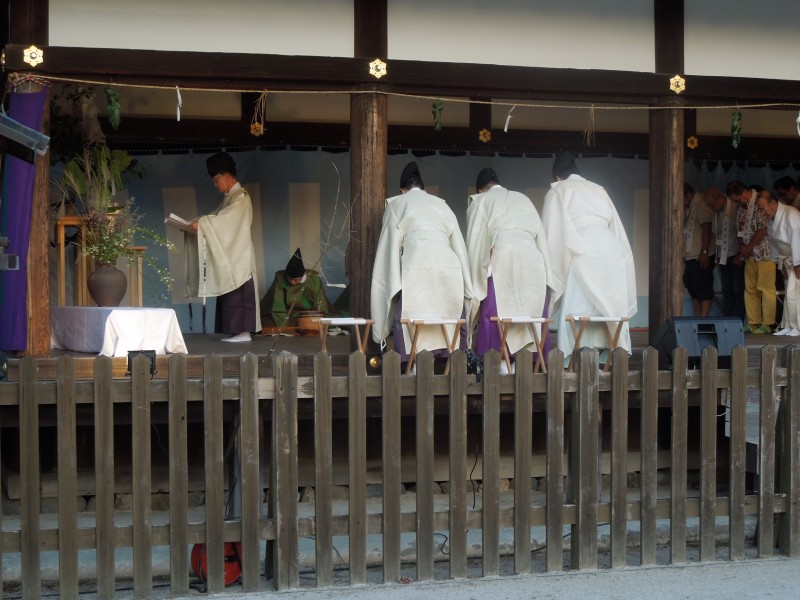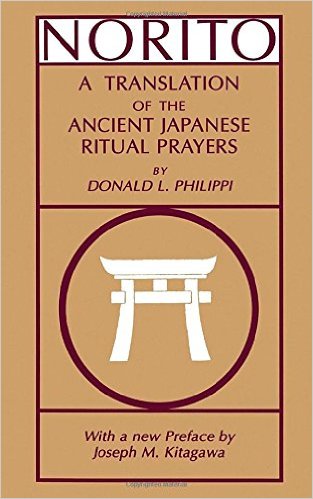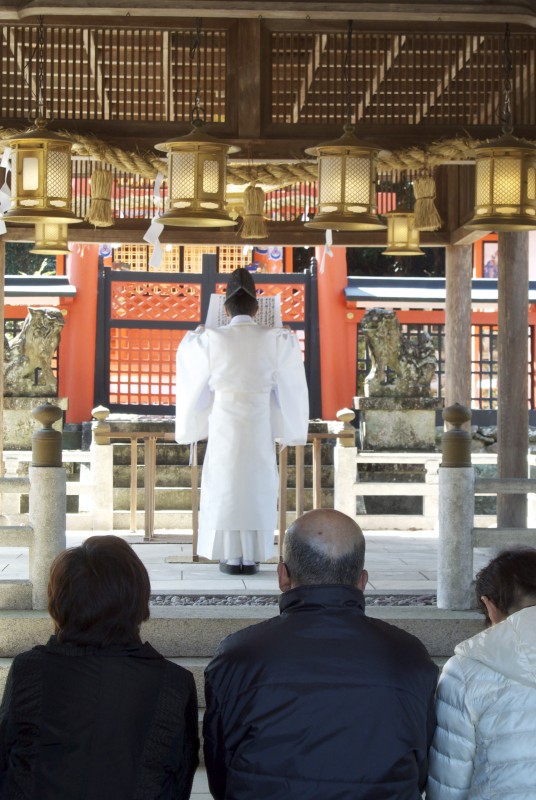
Norito being read out during a shrine ritual
During Shinto rituals formal prayers or declarations are made, which are known as norito. They first appear in the Kojiki (712) and in the Nihongi (720). But they are best-known from the Engi-shiki (927), in which the customs and regulations concerning ritual practice were compiled.
The archaic language of the norito means that in parts they are barely comprehensible to modern Japanese. In this respect they are similar to Latin in the old-style Catholic services. Proponents claim that the incomprehensibility adds to the mystical nature of the ritual, and that in the sounds themselves is an inherent beauty (in Shinto’s case the claim is that the sounds are imbued with kotodama, or word spirit).
For foreign followers of Shinto, there’s a curious dilemma in whether to use the Japanese or English version of the norito. Quite apart from the comprehensibility of the Japanese, wrong pronunciation will rob the language of kotodama. On the other hand, modern English translation will clearly have neither authenticity nor mystery. And then there’s the thorny issue of what language an overseas kami might use!
***************
 Norito, Translated by Donald L. Philippi 136 pages Princeton University Press
Norito, Translated by Donald L. Philippi 136 pages Princeton University Press
The norito (ritual prayers) found in the 10th-century Engi-shiki (“Procedures of the Engi Era”) have fascinated Japanologists for over a century.
In the introduction to his 1878 translation of the norito, Ernest Satow suggested that they could offer insight into “the rites practiced by the Japanese people before the introduction of Buddhism and Chinese philosophy.” More recently, they have also attracted attention from linguists interested in the earliest attested stages of the Japanese language.
Donald L. Philippi’s Norito: A Translation of the Ancient Japanese Ritual Prayers, originally published in 1959, walks a line between literal fidelity and readability that will be familiar to readers of his translations of the Kojiki or Ainu yukar (folk tales), which are both sadly out of print. In particular, Philippi’s use of indent levels to show parallel and nested phrases makes it so easy to grasp the intricate structures involved that compared to the unbroken paragraphs of the original this translation almost feels like cheating.
The 1990 edition from Princeton University Press contains a preface by religious historian Joseph Mitsuo Kitagawa that is well worth reading in its own right. Kitagawa argue for a view of the prayers as a product of the early Japanese state as it “came under the massive influence of Chinese civilization and Buddhism.”


My particular take on it all is, if you’re addressing Japanese specific kami then use the archaic Japanese used in traditional norito; otherwise, use a language you understand. Language does indeed have power or soul, but mainly through its interaction with the listener. The more the listener is affected or stimulated by the language the more power is has. The map is not the territory, and language is not the experience. At its best language points the listener towards the experience; that is the real power or soul of words in any language.
Thank you for that, Steven. As a practitioner, you must have gained insights into the workings of language as a spiritual tool. The question in my mind is the one raised by Protestantism in the sixteenth century. Why should a worshipper not address his or her God in his own language? The question involves a whole set of issues relating to the nature of kami, of course, but you make a fair point in noting that language is like a signpost. As Alan Watts noted in one of his talks, you can’t eat a pound note, or at least you can’t survive from it nutritionally. Since for me, language is the outer expression of an inner feeling or desire, it doesn’t really matter what form it takes, but the more carefully articulated it is, the more force it is likely to have. Hence the power of poetry.